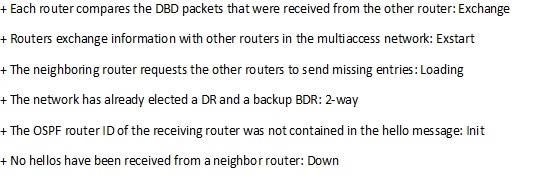Exam Details
Exam Code
:300-410Exam Name
:Implementing Cisco Enterprise Advanced Routing and Services (ENARSI)Certification
:CCNP EnterpriseVendor
:CiscoTotal Questions
:925 Q&AsLast Updated
:Aug 09, 2025
Cisco CCNP Enterprise 300-410 Questions & Answers
-
Question 841:
Which method changes the forwarding decision that a router makes without first changing the routing table or influencing the IP data plane?
A. nonbroadcast multiaccess
B. packet switching
C. policy-based routing
D. forwarding information base
-
Question 842:
Refer to the exhibit. The output of the trace route from R5 shows a loop in the network. Which configuration prevents this loop?

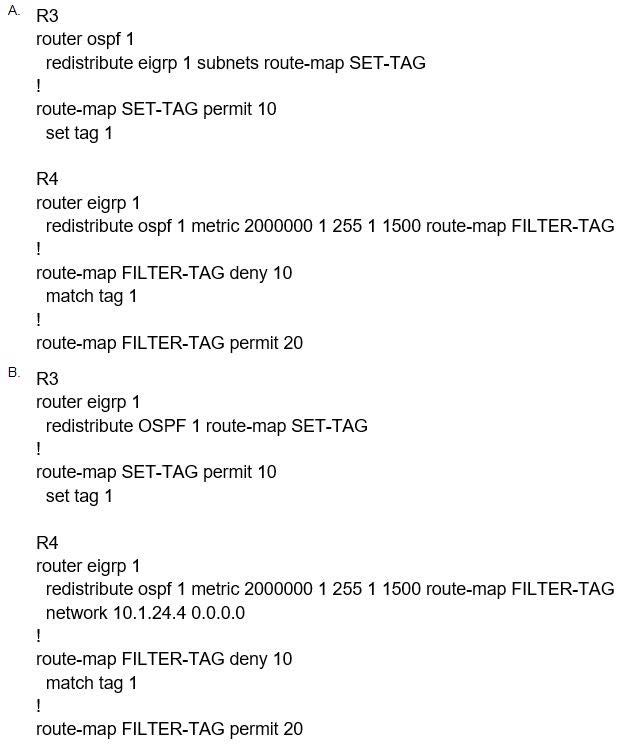
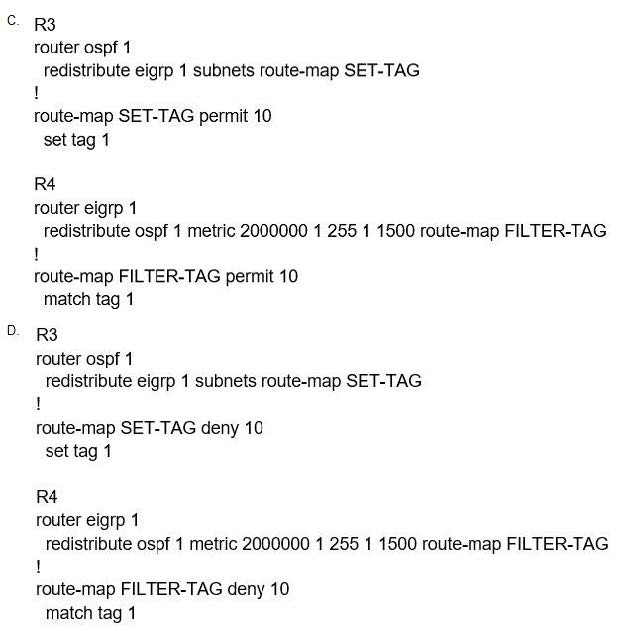
A. Option A
B. Option B
C. Option C
D. Option D
-
Question 843:
Refer to the exhibit. An engineer configures a static route on a router, but when the engineer checks the route to the destination, a different next hop is chosen. What is the reason for this?
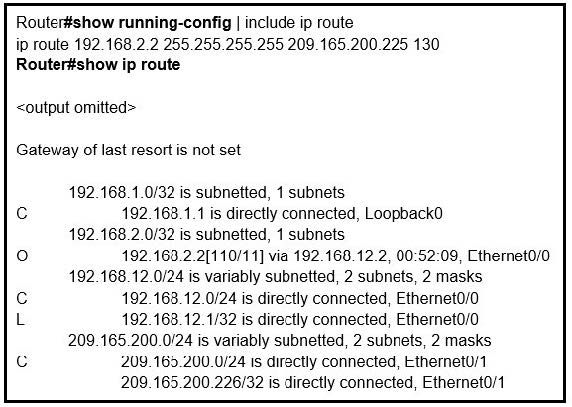
A. Dynamic routing protocols always have priority over static routes.
B. The metric of the OSPF route is lower than the metric of the static route.
C. The configured AD for the static route is higher than the AD of OSPF.
D. The syntax of the static route is not valid, so the route is not considered.
-
Question 844:
DRAG DROP
Drag and drop the OSPF adjacency states from the left onto the correct descriptions on the right.
Select and Place:

-
Question 845:
How are CE advertised routes segmented from other CE routers on an MPLS PE router?
A. with a combination of VRF-Lite and MP-BGP
B. by pushing MPLS labels advertised by LDP on customer routes
C. by enabling multiple instances of BGP, one for each CE router
D. by assigning CE-facing interfaces to different VRFs
-
Question 846:
Which Layer 3 VPN attribute installs customer routes in the VRF?
A. RD
B. RT
C. extended-community
D. MPLS label
-
Question 847:
Refer to the exhibit.
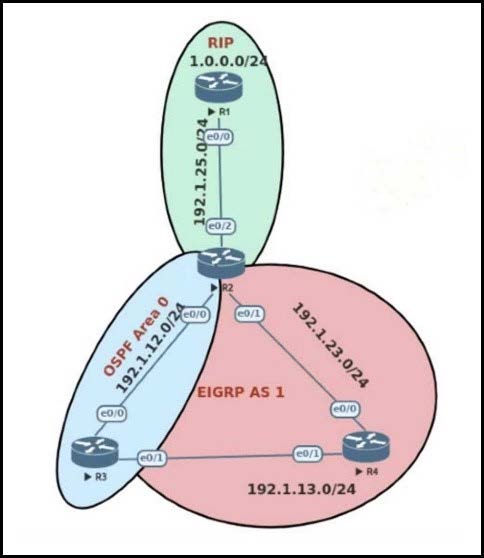
R3 is learning the 1.0.0.0/24 route through OSPF instead of EIGRP. Which action causes R3 to choose EIGRP to reach the 1.0.0.0/24 network?
A. Configure EIGRP administrative distance to 120.
B. Configure EIGRP administrative distance to 110.
C. Configure OSPF administrative distance to 120.
D. Configure OSPF administrative distance to 200.
-
Question 848:
Refer to the exhibit.
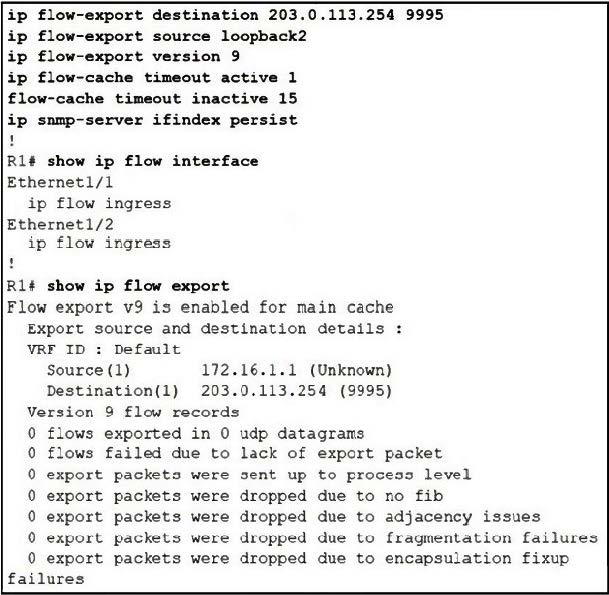
It was noticed that after NetFlow is configured in the router, the collector stopped receiving flow information. Which action resolves the issue?
A. Apply the ip flow egress command to the loopback2 interface.
B. Modify the source through the ip flow-export source loopback1 command.
C. Configure an IP address on the loopback2 interface to use as a source.
D. Change the IP address of the loopback 2 interface to a public IP address.
-
Question 849:
Refer to the exhibit.

R1 should receive 10.16.2.0/24 from R2. Which action resolves the issue?
A. Add prefix-list seq 1 on R1 to permit 10.16.0.0/22.
B. Add prefix-list seq 1 on R1 to permit 10.16.2.0/24.
C. Modify prefix-list seq 5 on R2 to permit 10.16.0.0/22.
D. Modify prefix-list seq 5 on R2 to permit 10.16.0.0/23.
-
Question 850:
Refer to the exhibit.

The primary link between R1 and R2 went down, but R3 is still advertising the 192.168.200.0/24 network to R1 and the 192.168.100.0/24 network to R2, which creates a loop. Which action resolves the issue?
A. Configure the eigrp stub command under the EIGRP process on R2.
B. Configure the summary-address 192.168.0.0 255.255.0.0 100 command on R3.
C. Configure the eigrp stub command under the EIGRP process on R3.
D. Configure the eigrp stub leak-map command under the EIGRP process on R1.
Related Exams:
300-410
Implementing Cisco Enterprise Advanced Routing and Services (ENARSI)300-415
Implementing Cisco SD-WAN Solutions (ENSDWI)300-420
Designing Cisco Enterprise Networks (ENSLD)300-425
Designing Cisco Enterprise Wireless Networks (ENWLSD)300-430
Implementing Cisco Enterprise Wireless Networks (ENWLSI)300-435
Automating and Programming Cisco Enterprise Solutions (ENAUTO)300-440
Designing and Implementing Cloud Connectivity (ENCC)350-401
Implementing and Operating Cisco Enterprise Network Core Technologies (ENCOR)
Tips on How to Prepare for the Exams
Nowadays, the certification exams become more and more important and required by more and more enterprises when applying for a job. But how to prepare for the exam effectively? How to prepare for the exam in a short time with less efforts? How to get a ideal result and how to find the most reliable resources? Here on Vcedump.com, you will find all the answers. Vcedump.com provide not only Cisco exam questions, answers and explanations but also complete assistance on your exam preparation and certification application. If you are confused on your 300-410 exam preparations and Cisco certification application, do not hesitate to visit our Vcedump.com to find your solutions here.

